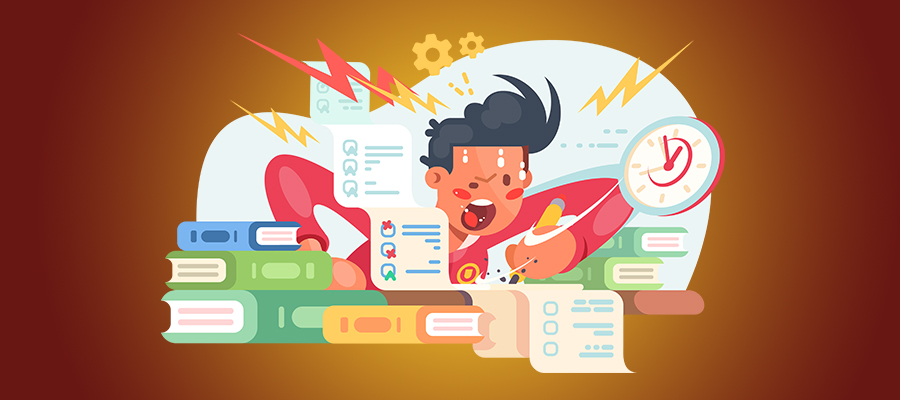Myths are those preconceived ideas, shared in droves, adorned with an aura of credibility, but which are false. They have a “tough skin” to break, despite the fact that we are collectively more educated and that the scientific method allows us to separate the wheat from the chaff, in other words, to distinguish a proven fact from an idea based on intuition alone. It is important to fight them, not only for the sake of truth but because they can have adverse effects on our perception of ourselves or others. Without further ado, let’s take a look at three myths that may hinder your learning process!
Those who sleep less are more productive
If your nights are short, you, of course, have more time to accomplish things in a day than a good sleeper. But what about the quality of your productivity, more precisely your cognitive performance? To this question, the preliminary conclusions of the largest ever conducted study on sleep indicate that sleeping 7 to 8 hours a day would be necessary to enjoy an optimal cognitive performance. But be careful not to go below or beyond this prescription, since lack of sleep as well as excess sleep—yes!—would impair our mental performance. According to the same study, sleeping 4 hours or less would be the worst-case scenario: participants forced to sleep in this pattern having achieved cognitive performance comparable to that of their older 8-year-old counterparts…
Accumulating dormant debt can cause us to lose 20% to 30% of our cognitive abilities, as Dr. Pierre Mayer, Director of the Sleep Clinic at the Centre Hospitalier de l’Université de Montréal (CHUM), explains in an interview on naptime. He mentions: “A two-hour sleep debt, i. e. sleeping only 6 hours over two weeks, is equivalent to a sleepless night or a blood alcohol level of 0.08%. “As for the idea that a cause-and-effect relationship unites some people’s ability to hyper-perform with their supposedly modest sleep needs, Dr. Mayer is clear: “Short sleepers don’t exist in science! When these short sleepers are put in the laboratory, after two weeks, they sleep for 7 to 8 hours, and their cognitive performance improves. So “short sleepers” are people who are often gifted and who, despite the decrease in their cognitive performance, will remain effective.”
Finally, one of the most important contributions of neuroscience, according to the French neuroscientist Stanislas Dehaene, is the importance of sleep for learning. Contrary to what we might think, when we sleep, the brain is far from being “at rest” (Rasch et al., 2006; Howard-Jones, 2010a). As Dehaene describes it, “the brain works more during sleep for learning than during the day before. During the day before, he records episodes; but during sleep, we discovered that he plays episodes of the day several dozen times, much faster than during the day. Something that took a second during the day will go twenty times faster, be replayed by the same neurons at night.” This nocturnal activity is essential for the encoding and consolidation of information, two processes necessary for learning (see Neurosciences: Learning in 4 steps). But beware of shortcuts: if sleep plays a role in these processes, it is wrong to say that we “learn” while sleeping!
Feeling confused and frustrated in learning is a bad sign
Well, no! It is quite normal to experience such feelings when you learn. Learning is not always a pleasure since it involves questioning what you thought you knew, coming up against your limits, making efforts to overcome them, repeating lessons or actions to master them, not necessarily understanding or succeeding the first time, etc. To progress as a learner, you must accept these uncomfortable feelings and overcome them. The good news, however, is that learning also generates feelings of deep well-being, including satisfaction and flow—often described as “the emotion of the optimal experience” (see 8 keys for engagement in learning).
The role of emotions in learning has long been overlooked because of the opposition between intellect and affect, and the assumption that “mental” activity goes hand in hand with a neutral emotional state. However, neuroscience has confirmed in recent years that we are seriously off course (see The Importance of Emotions in Learning); we now know that emotions and cognition are mechanisms that are more interdependent than distinct (Liu, Fu and Fu, 2009). That said, while it is perfectly normal for learning to make us experience less pleasant feelings, it is desirable, even necessary, that this process also provides us with pleasant emotions. However, these emotions must be related to learning, since any pleasant or positive emotion does not immediately promote this process. Conversely, a “negative” emotion, if it occurs in a punctual and moderate way, can motivate the learner to double his or her efforts to achieve his or her goal. However, the latter must want to succeed, believe in his/her chances of success and have access to resources, if necessary.
Knowing your learning “style” is a must
Visual, auditory, kinesthetic… Which of these learning styles is “yours”? Let’s not keep the suspense going: while you may prefer to learn in one of these three ways, none of them allows you to learn better. This is one of the “neuromyths,” these misconceptions about brain functioning, among the most persistent, having even succeeded in spreading into the educational field. A few thousand articles deal with the subject in academic and professional journals, not to mention the hundreds of books and thousands of websites devoted to it.
It must be said that research on learning styles is not new. It dates back to the 1930s but has intensified over the past 40 years, despite some lows. And the theory of “visual, auditory and kinesthetic” styles is only the tip of the iceberg; many other theoretical variations have been proposed, multiplying definitions and making this conceptual field quite confusing. In 2016, Marie Gaussel, researcher at the Veille & Analyses department of the French Institute of Education, examined this field of research in order to clarify it by reviewing the literature. She stated at the outset that “research on learning styles is disparate and fragmented and, so far, shows no consensus on the validity of the results.” She adds, “… learning styles, although many times mentioned in the scientific literature or not, have no scientifically validated basis. They are even fought by the neurosciences.”
Neuroscience has shed new light on how the brain works (see Neuroscience: learning in 4 steps) and has highlighted the fact that it is well capable of plasticity and that it changes as we learn. Steve Masson, a professor in the Faculty of Education at UQÀM and director of the Laboratoire de recherche en neuroéducation (LRN), is one of those who worked to unblock neuromyths, not only to correct the facts but also because these false beliefs can insidiously hinder learning.
In the article, Connaître les neuromythes pour mieux enseigner, Masson and her coauthor, doctoral student Jérémie Blanchette Sarrasin, state that “it seems particularly important to avoid classifying students in reductive categories associated with neuromyths (such as visual or auditory students). Indeed, in addition to being unfounded, this categorization may lead a teacher to believe that a student cannot succeed without considering his or her learning style, hemispheric dominance or intelligence type (Pasquinelli, 2012). More importantly, this categorization can influence the student’s perception of himself as a learner and lead him to believe that he can only learn visually if he has been told he is visually oriented (Newton, 2015).” Although the authors refer here to students who receive traditional classroom training, the warning applies equally to adult self-study learners!





